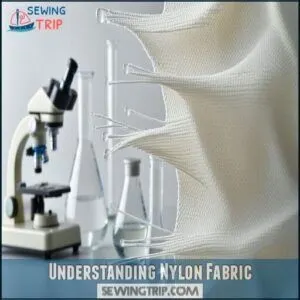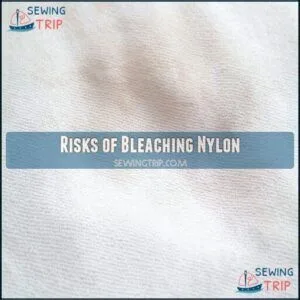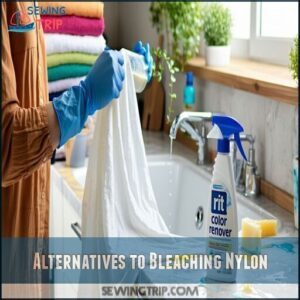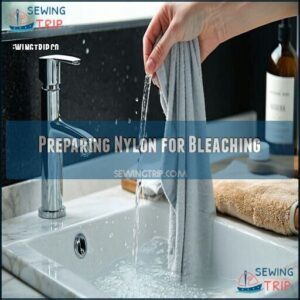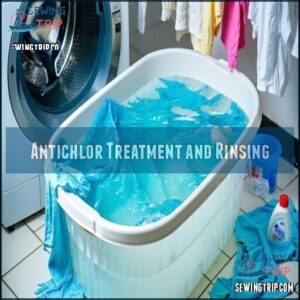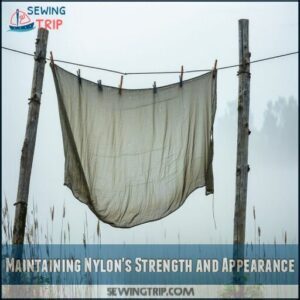This site is supported by our readers. We may earn a commission, at no cost to you, if you purchase through links.
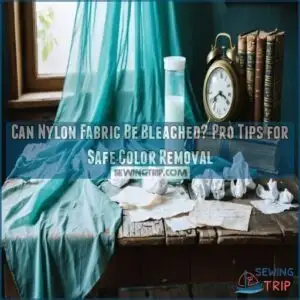
Standard chlorine bleach will destroy your fabric, so you’ll need specialized techniques.
Opt for sodium chlorite-based solutions and carefully control temperature and duration.
Always test a small, hidden area first to check for potential damage.
Dilute your bleaching agent thoroughly and work in a well-ventilated space.
Neutralize the bleach completely with an antichlor treatment to prevent fiber degradation.
Remember, nylon’s synthetic nature makes it sensitive to harsh chemicals.
One wrong move could turn your favorite garment into a disintegrating mess.
Curious about the safest bleaching methods for your delicate nylon items?
Table Of Contents
- Key Takeaways
- Can Nylon Fabric Be Bleached?
- Understanding Nylon Fabric
- Risks of Bleaching Nylon
- Alternatives to Bleaching Nylon
- Preparing Nylon for Bleaching
- The Sodium Chlorite Bleaching Process
- Antichlor Treatment and Rinsing
- Considerations for Nylon Nightgowns
- Maintaining Nylon’s Strength and Appearance
- Frequently Asked Questions (FAQs)
- Conclusion
Key Takeaways
- You can bleach nylon, but you’ll need to ditch chlorine bleach and opt for gentler alternatives like oxygen-based bleach or Rit Color Remover to prevent fiber damage.
- Always test a small, hidden area first and use precise techniques like carefully controlling water temperature (around 175°F) and limiting bleach exposure to 30 minutes to protect your fabric’s integrity.
- Neutralizing bleach is crucial – use an antichlor solution and multiple rinse cycles to remove chemical residues that could weaken your nylon’s strength and appearance.
- If you’re worried about damaging your fabric, consider creative alternatives like UV dyes, fabric spray paints, or specialized color removal techniques that won’t compromise your nylon garment’s structure.
Can Nylon Fabric Be Bleached?
Wondering if you can bleach nylon fabric? Tread carefully. While technically possible, traditional chlorine bleach can wreak havoc on your delicate nylon, causing unsightly yellowing and fiber degradation.
Your safest bet is oxygen-based bleach or specialized color removers like Rit Color Remover.
Prep is essential: thoroughly wash with mild detergent and rinse completely.
Steer clear of hydrogen peroxide, which can be too aggressive for nylon’s sensitive nature.
Creative alternatives like UV dyes or fabric spray paints offer bold transformations without risking your fabric’s integrity.
Remember, bleach safety isn’t just about color—it’s about preserving your nylon’s durability and appearance.
Understanding Nylon Fabric
If you’re wondering about bleaching nylon, you’ll want to understand its unique fabric properties first.
Nylon’s synthetic composition makes it strong and wrinkle-resistant, but it’s also sensitive to harsh chemicals that can compromise its integrity and appearance.
Nylon’s Unique Properties
Beneath the surface of nylon fabric lies a world of material science complexity. This synthetic wonder boasts unique properties that set it apart from traditional textiles:
- Incredible strength-to-weight ratio
- Remarkable chemical resilience
- Unparalleled moisture management
Nylon’s nylon structure combines fiber strength with impressive durability. Its molecular composition makes it resistant to wrinkles and wear, creating a fabric that’s both flexible and tough.
In the process of bleaching synthetic fabrics, understanding nylon’s intricate nature is essential. Think of it like a high-performance athlete – powerful, but requiring precise care and specific handling. Your nylon garments demand respect, responding best to gentle treatments that preserve their inherent qualities while maintaining their distinctive performance characteristics.
Challenges With Dyeing Nylon
When working with nylon, you’ll quickly discover its unique dyeing challenges that can test even experienced textile enthusiasts.
Unlike natural fibers, nylon’s smooth synthetic structure resists traditional colorants, making color application tricky.
Acid dyes offer the best solution, chemically bonding with nylon’s amino groups to create lasting color.
Pre-treatment methods like thorough scouring help remove manufacturing oils, improving dye absorption and preventing uneven coloration.
Temperature control becomes vital, especially when using disperse dyes, to guarantee consistent results.
Without careful approach, you might face colorfastness problems where colors wash out quickly, leading to frustrating fabric weakening and discoloration that can compromise your textile project, which requires careful consideration of temperature control and pre-treatment methods to achieve the desired lasting color and prevent uneven coloration.
Risks of Bleaching Nylon
When you’re thinking about bleaching nylon, you’ll want to proceed with caution, as the process can potentially damage your fabric’s integrity.
Harsh chemicals like chlorine bleach can weaken nylon fibers, cause permanent yellowing, and compromise the material’s strength and appearance, which is why it’s crucial to handle nylon fibers with care.
Potential Damage to Nylon Fibers
The delicate dance between bleach and nylon fabric demands careful consideration to prevent irreversible damage.
When harsh chemicals meet synthetic fibers, several critical transformations occur:
- Microscopic fiber breakage weakens fabric integrity
- Material degradation reduces structural resilience
- Chemical reactions compromise molecular bonds
- Elasticity loss destroys garment shape
Nylon’s natural resistance crumbles with each bleaching exposure, creating increasingly vulnerable fabric.
Tensile strength plummets as microscopic fiber damage accumulates, transforming your once-robust garment into a fragile shadow of its former self.
Instead of risking permanent nylon fabric damage, explore gentler alternatives like oxygen-based bleach or specialized color removers that preserve your fabric’s essential characteristics while achieving your desired aesthetic transformation.
Yellowing and Discoloration
Most synthetic fibers become vulnerable to yellowing when exposed to harsh bleach treatments.
Chlorine bleach can transform white nylon into an unsightly yellow mess, causing permanent fabric discoloration. Your best defense? Use color-safe oxygen bleach, which gently removes stains without compromising the nylon’s integrity.
Neutralize potential yellow stains by understanding fiber weakening mechanisms and choosing fabric-friendly whitening methods. Understanding bleach resistant fabrics is essential to avoid damaging your nylon materials, and using oxygen bleach can help prevent permanent discoloration.
Alternatives to Bleaching Nylon
When traditional bleaching might damage your nylon fabric, you’ll want to explore safer alternatives that preserve your garment’s integrity.
From Rit Color Remover to creative spray paint techniques, you can refresh your nylon without risking its durability or appearance, using methods that are safer and more creative.
Using Rit Color Remover
When it pertains to color removal from nylon, Rit Color Remover stands out as a gentle yet powerful solution for fabric transformation. This color-safe method offers a safe alternative to harsh bleaching techniques.
- Prepare hot water (140°F) in a sink
- Dissolve one package of Rit Color Remover
- Submerge pre-washed nylon fabric
- Agitate and maintain temperature for 10-30 minutes
Before proceeding, always test the product on a hidden area to guarantee the best results. You’ll appreciate how Rit Color Remover safely strips unwanted color while preserving your nylon’s strength and texture, giving you the confidence to refresh your fabrics without damaging their delicate fibers.
Understanding the color remover process is key to achieving the desired results with Rit Color Remover.
Exploring Spray Paint Options
When you’re ready to transform your nylon fabric, fabric paint spray offers a game-changing alternative to traditional bleaching methods.
These specialized sprays bond seamlessly with synthetic materials, giving you precision and creative control.
Design stencils become your artistic ally, helping you craft intricate patterns with ease.
Before diving in, prepare your fabric carefully by cleaning thoroughly and working in a well-ventilated space.
Test the paint in a hidden spot to confirm compatibility and prevent unexpected results.
Layer different shades using strategic spray techniques to develop unique color effects that breathe new life into your garment.
Experiment boldly, but always prioritize paint safety and your fabric’s integrity.
With the right approach, you’ll discover endless color possibilities without risking fabric damage.
Preparing Nylon for Bleaching
When you’re preparing to bleach nylon fabric, you’ll need to start with a thorough cleaning process that removes all dirt, debris, and potential stains.
You’ll want to carefully check the care label, treat any stubborn marks with a gentle stain remover, and make certain your fabric is completely clean and dry before attempting any bleaching technique.
This process ensures that your fabric is properly prepared for the bleaching process, and helps prevent any damage or discoloration, by following a thorough cleaning process.
Thorough Scouring and Cleaning
You’re about to set out on a fabric transformation journey, and your first stop is a thorough cleaning.
Think of your nylon as a canvas waiting for its masterpiece—every speck of dirt can sabotage your bleaching adventure. Grab a mild detergent designed for synthetics and cool water to protect those delicate fibers.
Clean carefully, protect your nylon’s delicate canvas—every drop matters in this transformative fabric journey.
Tackle stubborn stains with a pre-wash treatment, working methodically to extract every trace of grime. Your care label is your roadmap; follow it religiously.
Using the right mild detergent products is vital for the cleaning process. By giving your fabric a thorough scrub-down, you’re setting the stage for a successful color removal mission that’ll make your nylon shine like new.
Avoiding Hydrogen Peroxide
Hydrogen peroxide often wreaks havoc on delicate nylon fabrics, acting more like a fabric assassin than a helpful cleaning agent.
Beware hydrogen peroxide: the silent destroyer of delicate nylon fabrics, ready to unravel your beloved garments with ruthless precision.
To protect your cherished garments, consider these safe bleaching alternatives:
- Leverage the sodium chlorite process for gentle whitening
- Select oxygen bleach as a color-safe option
- Experiment with Rit Color Remover for stubborn stains
- Embrace natural lightening techniques using lemon juice and sunlight
Prioritize fabric protection and chemical safety to preserve your nylon’s pristine condition and extend its lifespan.
The Sodium Chlorite Bleaching Process
When you’re ready to transform your nylon fabric using the sodium chlorite bleaching process, you’ll want to pay close attention to precise temperature control and rinsing techniques.
This method offers a strategic approach to safely lightening your fabric while minimizing potential damage to its delicate fibers.
Proper Rinsing and Overflow Techniques
After carefully scouring your nylon fabric, master the art of thorough rinsing.
Use cool water and gently stir the fabric to guarantee even bleach neutralizing. Your container should accommodate twice the fabric’s volume to prevent overflow.
Keep water temperature below 75°F to protect nylon’s delicate fibers. Multiple rinse cycles are your ally—continue until water runs crystal clear, signaling complete residue removal.
Pro tip: Proper bleach dilution beforehand reduces rinse cycles, saving time and preserving your fabric’s integrity. Patience pays off in fabric bleaching safety.
Controlling Temperature and Duration
The bleaching alchemist’s secret weapon is precise temperature control. When transforming nylon, follow these critical temperature guidelines:
- Set water temperature to 175°F (80°C)
- Limit bleach exposure to 30 minutes
- Run antichlor bath at 170°F (76°C)
- Complete final rinse at 140°F (60°C)
- Monitor soaking time with laser-like precision
Your fabric’s survival depends on these temperature settings—too hot and you’ll destroy the fibers, too cool and stains won’t budge. Master these limits to preserve your nylon’s integrity.
Understanding rayon bleach resistance is also vital for working with delicate fabrics.
Antichlor Treatment and Rinsing
After bleaching your nylon fabric, you’ll need to neutralize any lingering chemicals to protect the material’s integrity.
Antichlor treatment guarantees complete removal of bleach residue, preventing potential fiber damage and preserving your fabric’s strength and appearance.
Neutralizing Residual Bleach
After carefully processing the sodium chlorite bleach, you’ll want to neutralize those lingering chemicals to protect your nylon fabric.
An antichlor solution using sodium bisulfite becomes your fabric’s safety net. Here’s what you need to know:
- Prevent fiber weakening through strategic neutralization
- Deactivate bleach remnants completely
- Safeguard against future fabric damage
Your warm water bath at 175°F will work magic, with a 15-minute soak that guarantees bleach removal.
Think of this step as a protective shield for your delicate nylon, washing away potential yellowing and preserving the fabric’s strength.
A vinegar rinse can further help neutralize any residual bleach concentration, ensuring your fabric stays vibrant and intact.
Ensuring Complete Removal of Impurities
After neutralizing bleach, your nylon needs a final purification dance.
The antichlor bath at 100°F washes away chemical ghosts, while heat treatment at 175°F guarantees deep cleaning.
An overflow rinse at 140°F sweeps away lingering impurities, and a cool final rinse leaves your fabric pristine.
Think of it as a spa treatment for your delicate nylon, where every step strips away unwanted residues, restoring its original beauty.
Understanding bleach resistant fabrics is vital for effective and safe color removal.
Considerations for Nylon Nightgowns
If you’re looking to transform a nylon nightgown without risking damage, you’ll want to explore alternative color modification techniques.
Discover gentle methods like UV dyes and fabric painting that can help you achieve your desired look while preserving the delicate fabric’s integrity.
Exploring UV Dyes and Painting Options
When transforming your nylon nightgown, UV dyes and fabric-safe spray paints reveal creative color options without compromising fabric integrity.
Consider these design techniques:
- Select UV-reactive dyes engineered for synthetic materials
- Perform adhesion tests on hidden fabric sections
- Apply thin, uniform layers preserving the garment’s elegant drape
UV painting techniques deliver vibrant dye effects while maintaining your fabric’s strength and original character.
The use of UV dye products can enhance the overall appearance of the nightgown, using fabric-safe methods to achieve the desired look with creative color options.
Achieving The Desired Ghostly Effect
Want to transform your nylon nightgown into a hauntingly ethereal piece? Master the art of strategic bleach application with color-safe solutions.
Your ghostly effect depends on precise layering and controlled fading techniques, considering the fabric stretch properties.
Here’s a quick guide to achieving that spectral charm:
| Technique | Concentration | Effect |
|---|---|---|
| Light Spray | Low | Subtle Fade |
| Dip Method | Medium | Gradual Shift |
| Targeted Application | High | Dramatic Texture |
The key to success lies in the precise layering and understanding of the fabric properties, ensuring your nightgown achieves the desired dramatic texture.
Maintaining Nylon’s Strength and Appearance
You’ll want to protect your nylon fabric’s integrity when attempting color removal, as improper bleaching can compromise its strength and appearance.
By following careful techniques and understanding the risks, you can minimize damage and preserve your fabric’s essential qualities while achieving your desired color transformation.
Preventing Damage During Bleaching
With gentle precision, protecting your nylon fabric from bleach damage requires strategic preparation. Master the art of safe color removal by following these critical guidelines:
- Test a hidden patch before full treatment
- Dilute bleach with 10 parts water
- Maintain water temperature under 85°F
- Set strict time limits for bleaching
- Rinse thoroughly until water runs clear
By implementing these damage control techniques, you’ll preserve your fabric’s integrity while achieving the desired color transformation. Bleach safety isn’t just a recommendation—it’s your fabric’s lifeline.
Ensuring Long-Lasting Results
After working hard to bleach your nylon, protect your results with smart fabric care strategies.
Use color-safe bleach alternatives and wash in cold water to maintain fiber protection and dye stability.
Rinse thoroughly to remove chemical residues that could compromise your nylon’s integrity.
When drying, choose line-drying or low heat settings to prevent unnecessary wear.
Store your treated items away from direct sunlight, which can fade colors and weaken fabric fibers.
These precautions will help you preserve your nylon’s strength and appearance long after bleaching.
Frequently Asked Questions (FAQs)
Can you bleach nylon fabric?
You can bleach nylon, but tread carefully.
Oxygen bleach works best, while chlorine bleach risks damaging your fabric.
Always test a small area first, follow care labels, and dilute bleach properly to protect your nylon garments.
Can you use too much bleach on nylon?
Overexposure to bleach can weaken nylon by 56%, causing irreversible damage.
You’ll want to dilute bleach carefully, limit exposure time, and follow precise instructions to prevent fiber breakdown and maintain your fabric’s integrity.
This is to prevent fiber breakdown and ensure the longevity of your fabric.
Can you use chlorine bleach on white nylon fabric?
You’ll want to steer clear of chlorine bleach on white nylon.
It’ll damage the fabric, weaken fibers, and cause permanent yellowing.
Opt for oxygen-based bleach to safely brighten and protect your white nylon items.
What is the best bleach for nylon?
Oxygen bleach is your safest bet for nylon. It’ll brighten colors without damage, protecting your fabric’s integrity while effectively removing stains – just follow the instructions carefully and you’ll be golden.
Does bleach whiten nylon?
Like a double-edged sword, bleach can whiten nylon, but it’s risky.
You’ll want to use oxygen-based bleach carefully, testing a small area first.
Non-chlorine options preserve your fabric’s integrity while gently lifting stains.
Can you bleach a nylon shirt?
You can bleach a nylon shirt, but choose non-chlorine bleach carefully.
Test a hidden spot first, use a diluted solution, and rinse thoroughly to prevent damage.
Harsh chemicals can weaken the fabric’s strength and color.
Can you use bleach on nylon?
Hold your horses before reaching for that bleach bottle.
You can use non-chlorine bleach on nylon, but chlorine bleach is a no-go.
Dilute carefully, test first, and follow fabric care instructions to prevent damaging your garment, using non-chlorine bleach.
Can you remove color from nylon fabric?
You can strip color from nylon using non-chlorine bleach or gentler methods like Rit Color Remover.
Test a small area first, choose a color-safe method, and follow precise instructions to prevent fabric damage.
How do you whiten nylon fabric?
Did you know 56% of nylon’s strength can be lost through harsh bleaching?
Carefully use oxygen-based bleach, dilute it with water, test a hidden spot first, and rinse thoroughly to whiten your nylon fabric safely and effectively, which helps prevent loss of nylon’s strength.
What fabrics should not be bleached?
You’ll want to steer clear of delicate fabrics like wool, silk, leather, and spandex when bleaching.
Dyed or colored clothes, especially synthetics, can get damaged or discolored, so always check the care label first.
Conclusion
Imagine delicate nylon threads as fragile dancers, waiting to be transformed.
In the case of bleaching nylon fabric, you’ve learned that precision is key. Whether you’re using sodium chlorite or alternative methods, always test first and proceed cautiously.
Can nylon fabric be bleached? Yes, but with extreme care.
Protect your fabric’s integrity by following professional techniques, controlling temperature, and neutralizing chemicals.
Your nylon garments will thank you for the gentle, informed approach.

